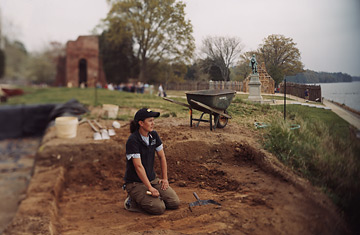
When archaeologists first started digging in Jamestown in the 1930s, they turned up more than half a million artifacts–but not a trace of the original fort. In fact, nobody expected to find it. Based on a handful of written eyewitness accounts and two maps, the James Fort was widely believed to have been built at the west end of Jamestown Island, close to the deepwater channel where the colonists presumably moored their ships. The river had washed away some 25 acres of that part of the island long ago, however, and most archaeologists figured the site of the fort had ended up on the river bottom.
William Kelso disagreed. Unlike his colleagues, Kelso, a specialist in colonial American archaeology who began working for the Association for the Preservation of Virginia Antiquities in 1993, was convinced that the fort lay instead somewhere close to the brick church tower built in 1690, the only surviving structure from the colony’s first century. So on April 4, 1994, he put his shovel in the ground, and less than an hour later turned up fragments of early 17th century ceramics. Over the next few months, Kelso and a team of volunteers uncovered a series of circular stains in the soil–the marks of logs that had once stood upright but had long since rotted away.
Although it took him another 10 years of slow, patient work, Kelso eventually managed to map out the triangle shape of the fort along with the foundations of at least five buildings, several wells and a burial ground. His team has also dug up more than a million artifacts, about twice the number found over the previous half-century, including arms and armor, pottery, clay pipes, clothing and shoes, iron tools, jewelry, animal bones, trade beads, sheets of copper and hundreds of stone points. Individually, these objects seem trivial. Taken together, however, they’re yielding an extraordinary picture of who the colonists were and how they lived–something contemporaneous written accounts couldn’t come close to doing.
Perhaps the most unexpected discovery is evidence that Indians, whom the settlers assumed would be uniformly hostile, actually lived in the fort for some period of time. Trash pits, for example, yielded fragments of an Indian reed mat as well as shell beads favored by the Indians and the type of stone tool that they would have used to drill them. The Indian artifacts were found mixed in with English ones in an undisturbed layer of soil and in greater concentrations than have ever been found in Virginia Indian villages. That, and the fact that the Indians bothered to carry tools like the stone drills into the fort, has led archaeologists to think the Indians spent significant amounts of time there. “It must have been a very close relationship,” says Kelso. “No one really talks about that.”
Additional evidence of the Indians’ presence in the fort comes from one of the buildings Kelso’s team excavated. Known as “the quarter,” it was at least 30 ft. long by 18 ft. wide and appears to have been built using a mud-and-stud technique that was popular in Lincolnshire, England, during the early 17th century. In one corner of its cellar the archaeologists found a butchered turtle shell and pig bones, as well as an Indian cooking pot with traces of turtle bone inside. Nearby were a Venetian trade bead, a sheathed dagger and a musketeer’s kit bag. As a result, Kelso surmises that an Indian woman may have cooked for the inhabitants.
Kelso’s team has also uncovered a modest cemetery within the fort. The plot, which dates to the colony’s earliest years, holds at least 23 individuals: 19 single burials and two double burials (most likely people who died on the same day). One of the single graves contained the remains of a boy with a stone arrowhead in his leg, a broken collarbone and a jawbone that had been partially excised due to an abscess. The position of the bones, the lack of coffin nails and the abundance of straight pins scattered in the graves opened so far indicate that some of the bodies were interred in simple shrouds without coffins.
Another burial ground outside the walls of the fort, dating from 1610 to 1630, holds some 80 individuals. From them, forensic anthropologists at the National Museum of Natural History in Washington determined that the average male inhabitant died at age 25, with women living slightly longer. (At the time, Kelso notes, life expectancy for lower-class residents of London was about 20 years; for the upper class, it was about 40.) To the scientists’ surprise, hardly any of the graves contained infants.
But perhaps the most significant discovery was a lone grave with the remains of a ceremonial staff inside. Kelso believes it is the resting place of Bartholomew Gosnold, captain of the Godspeed, who died on Aug. 22, 1607, after a “three-week illness.” DNA tests on the skeleton have been inconclusive.
The colonists were ill-prepared for life in Virginia and, at least initially, had no crops to harvest. So Kelso was not surprised to dig up the goods they offered the Indians in exchange for food. Among them: Venetian glass beads (blue ones were preferred), sheet copper (a commodity prized by the Powhatan, who wore pendants and other ornaments fashioned from the reddish metal), European coins (useless in Virginia) and metal tools (the Indians had ones made only from stone, wood, bone and shell). By the 1660s, when the English had established a number of settlements in the area, the Indians were even issued silver or copper badges that allowed them safe passage while conducting business with the foreigners.
A comprehensive selection of artifacts from Kelso’s digs is on display in a $4.9 million facility known as the Archaearium that opened at Historic Jamestowne last May. His team is now excavating beneath the Civil War–era earthen fort that rises in the middle of James Fort in search of the colony’s earliest church–just in time for Jamestown’s 400th-birthday celebration.